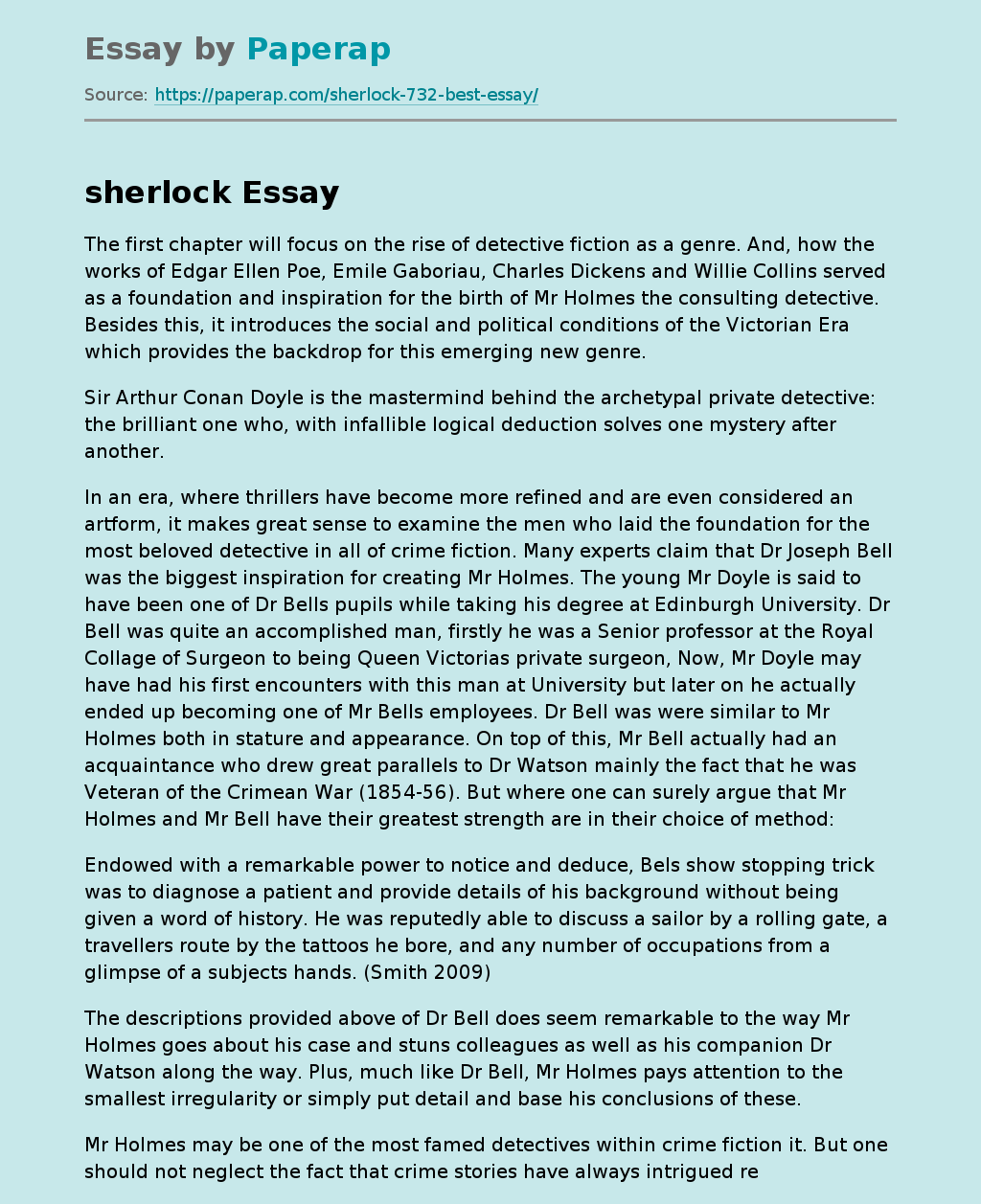The Rise of Detective Fiction as a Genre
The following sample essay on “The Rise of Detective Fiction as a Genre” рассказывается how the works of Edgar Ellen Poe, Emile Gaboriau, Charles Dickens and Willie Collins served as a foundation and inspiration for the birth of Mr Holmes the consulting detective. Besides this, it introduces the social and political conditions of the Victorian Era which provides the backdrop for this emerging new genre.
Sir Arthur Conan Doyle is the mastermind behind the archetypal private detective: the brilliant one who, with infallible logical deduction solves one mystery after another.
In an era, where thrillers have become more refined and are even considered an artform, it makes great sense to examine the men who laid the foundation for the most beloved detective in all of crime fiction. Many experts claim that Dr Joseph Bell was the biggest inspiration for creating Mr Holmes. The young Mr Doyle is said to have been one of Dr Bells pupils while taking his degree at Edinburgh University.
Dr Bell was quite an accomplished man, firstly he was a Senior professor at the Royal Collage of Surgeon to being Queen Victorias private surgeon, Now, Mr Doyle may have had his first encounters with this man at University but later on he actually ended up becoming one of Mr Bells employees. Dr Bell was were similar to Mr Holmes both in stature and appearance. On top of this, Mr Bell actually had an acquaintance who drew great parallels to Dr Watson mainly the fact that he was Veteran of the Crimean War (1854-56).
But where one can surely argue that Mr Holmes and Mr Bell have their greatest strength are in their choice of method:
Endowed with a remarkable power to notice and deduce, Bels show stopping trick was to diagnose a patient and provide details of his background without being given a word of history. He was reputedly able to discuss a sailor by a rolling gate, a travellers route by the tattoos he bore, and any number of occupations from a glimpse of a subjects hands. (Smith 2009)
The descriptions provided above of Dr Bell does seem remarkable to the way Mr Holmes goes about his case and stuns colleagues as well as his companion Dr Watson along the way. Plus, much like Dr Bell, Mr Holmes pays attention to the smallest irregularity or simply put detail and base his conclusions of these.
Mr Holmes may be one of the most famed detectives within crime fiction it. But one should not neglect the fact that crime stories have always intrigued readers. Some academics even argue that such stories can be traced back to the Holy book. Yet, the modern notion of thrillers emerged in small spurts since the 10th century. As Mr John Scaggs proclaim:
During the same period that science was first being pressed into the service of crime-solving, the first detective stories, in which the analytical and rational deductive ability of a single, isolated individual provides the solution to an apparently inexplicable crime, were being published. (Scaggs 2005)
Sherlock may be the most famous detective in all of history, but he was not the first detective created. The first detective ever created is claimed to be Mr Monsieur. Aguste Dupin who is one of Edgar Allan Poes creations. Mr Dupin was conceived in 1841 and take an analytical approach to his craft.
Now, one can see that Mr Doyle was not only inspired by Mr Poe but also a range of other crime fiction writers. On such writer was Wilkie Collins (1824-89) and his novel The Moonstone (1868) which clearly influenced Conan Doyles A Study in Scarlet. (Scaggs 2005) He goes on to point of that a specific part of Doyles The Sign of Four (1890) draws great parallels to the treasure theme and Indian sub-plot (Scaggs 2005) of Mr Collins The Moonstone. Another writer Mr Doyle sees as his guiding light is Mr Poe and how he presented his detective and companion. Attributes Mr Doyle took from Poes detective Dupin was his eccentricities, reclusive nature, his tendency to show off and finally his approach to his work.
The final creative mind who will be mentioned is Mr Emil? Gaboriau who is the mind behind the amateur detective Tabaret who can only be likened to Mr Holmes and Mr Dupin by way of interlect. One point where readers can draw a direct comparison between these power houses of crime fiction is their use of split narrators. Or as Mr Scaggs writes narratives in: in which long sections describing events that have led to the current crisis are embedded within a framing narrative of investigation and deduction in the present. (Scaggs 2005) The trick of split narrative is especially prevalent in Doyles A Study in Scarlet.
The Rise of Detective Fiction as a Genre. (2019, Dec 17). Retrieved from https://paperap.com/sherlock-732-best-essay/

